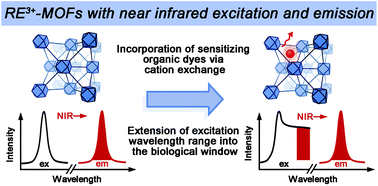Near infrared excitation and emission in rare earth MOFs via encapsulation of organic dyes†
Abstract
We successfully demonstrate that metal–organic frameworks (MOFs) can be designed to be excited and emit within the biological diagnostic window (650–1450 nm). An isoreticular series of anionic rare earth MOFs with fcu topology was synthesized using 10 different rare earth elements (Y3+, Eu3+, Gd3+, Tb3+, Dy3+, Ho3+, Er3+, Tm3+, Yb3+, Lu3+) and common linear ditopic ligands. Five different cationic dye molecules were incorporated into the MOFs via ion exchange. When LDS 750, which exhibits low-energy absorption in the range 450–770 nm, is loaded into an Yb3+-MOF, it can be used as an antenna to sensitize the near-infrared (NIR) emission of Yb3+ centred at 980 nm.



 Please wait while we load your content...
Please wait while we load your content...